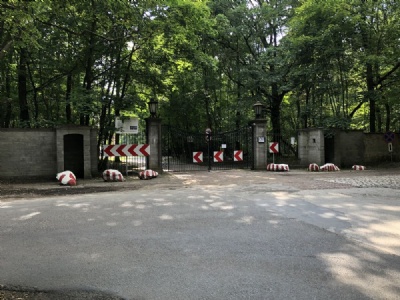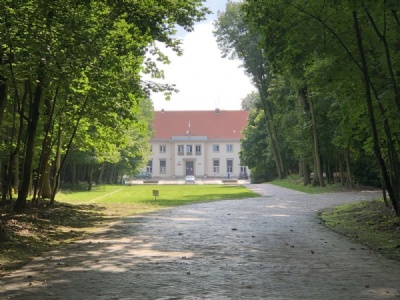Posen – Jeziory
About twenty kilometres south of Poznan (german Posen) lies Jeziory, anf there Nazi governor, Arthur Greiser, had taken over a mansion for private use. The manor was well secluded and surrounded by forests and a lake. Here Greiser could relax with his family and arranged various events and dinners for both private and official guests.
Arthur Gresier was a hard-line Nazi who had joined the Nazi party in 1929. The following year, he became a member of the SS and became one of the SS chief Heinrich Himmler’s earliest employees. He was married twice, first to Ruth with whom he had three children, and then to Maria whom he married in 1934. Both wives survived Greiser, but two of his children died during his life.
Greiser began his political career in the free city of Danzig in 1930 when he was appointed deputy district leader of the Nazi party. After the Nazis’ successful elections in 1933, he became deputy president of Danzig’s senate in June. In November 1934 he became president of the senate, a post he held until September 1, 1939, when he was replaced by Albert Forster. Greiser and Forster fought for political power in Danzig, but in the end Hitler chosed Forster, who thus became the supreme Nazi leader in the district of Danzig-Western Prussia.
But Hitler understood Greiser’s potential and loyalty and appointed him supreme leader of the district of Warthegau in October, 1939. A district that consisted of both former German areas and occupied Polish areas but now became part of the german empire. As governor, he was Hitler’s closest co-worker and responsible for the germanization in the district. This meant that everything that was considered Polish or jewish would disappear and be replaced with German values. Poles and Jews were subject to German laws and regulations. Murder, slave labour, imprisonment and ill-treatment were means that were applied when laws were not enough.
Thousands of Poles were deported to other areas outside Warthegau and replaced with ethnic germans who was re-located to Warthegau from other areas, including the Baltic states, Volhynia and the Balkans. Sometimes against their will to do so. Between 1939 and 1943, the German population increased by about 600,000. Jews were sent to ghettos and extermination camps. In many ways, Greiser’s treatment of Poles was the same as against the Jews. Both suffered a brutality where the goal was to enslave and subjugate the poles and destroy the Jews. For Greiser, poles was just as big a threat as the Jews, if not a bigger threat. An approach not always shared by other hardline Nazis.
Although Gresier was not the initiator of the first Nazi extermination camp at Chelmno and the ghetto in Lodz (both were within his district), they were both in line with his ambitions. Greiser visited both Chelmno and the ghetto in Lodz. In connection with the liquidation of Chelmno in 1943, he visited Chelmno and congratulated the SS for the work they had done. He suggested that all staff should get much-needed vacation and that they all were welcome to spent it on his estates. He also invited everyone involved to a farewell party shortly after Chelmno was closed.
At the end of the war he fled to the Bavarian alps where he surrendered to the americans. When it became clear who he was, he was handed over to Poland, where he was brought to justice for the crimes he committed as governor of Warthegau. He was sentenced to death and hanged on 21 July, 1946, in front of about 15,000 spectators at fort Winiary in Poznan. This was the last public execution in Poland.
Current status: Preserved (2021).
Location: 52°16' 08.01" N 16°47' 49.79" E
Get there: Car.
Follow up in books: Epstein, Catherine: Model Nazi: Arthur Greiser and the occupation of western Poland (2010).


The Mansion is now some form of a nature museum. At the gate to the mansion there are two sentry-boxes probably built on Greiser’s orders. The area around the mansion seems to be a popular hiking area with both longer and shorter walking paths.